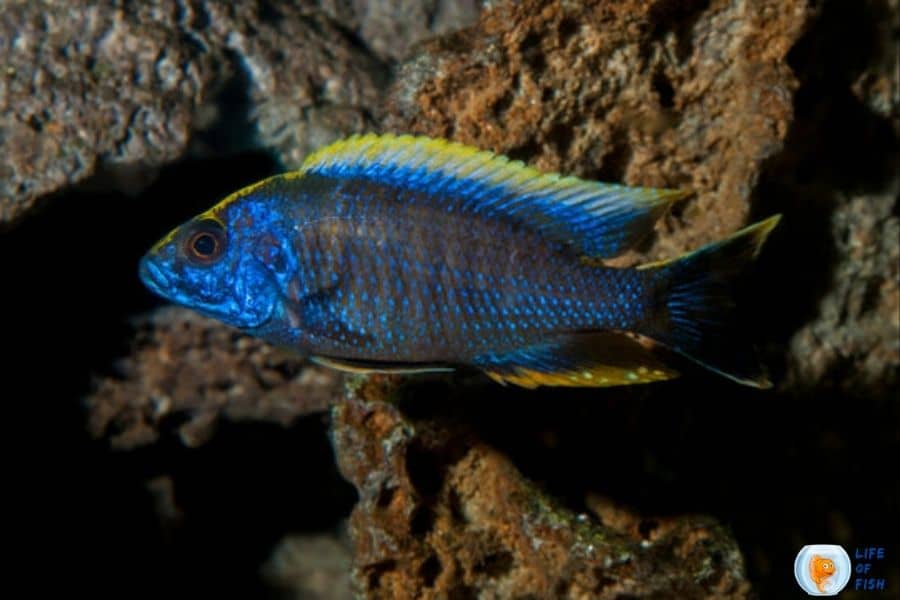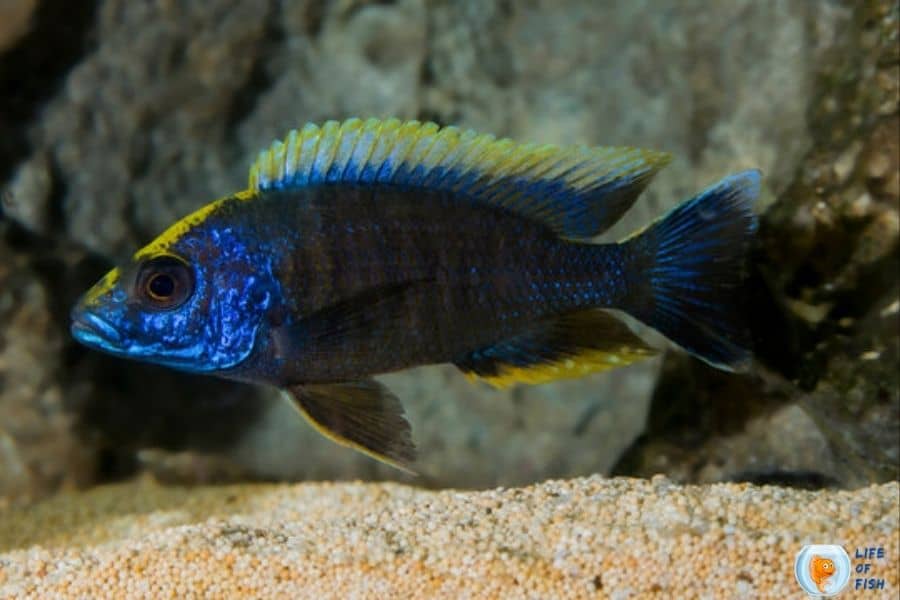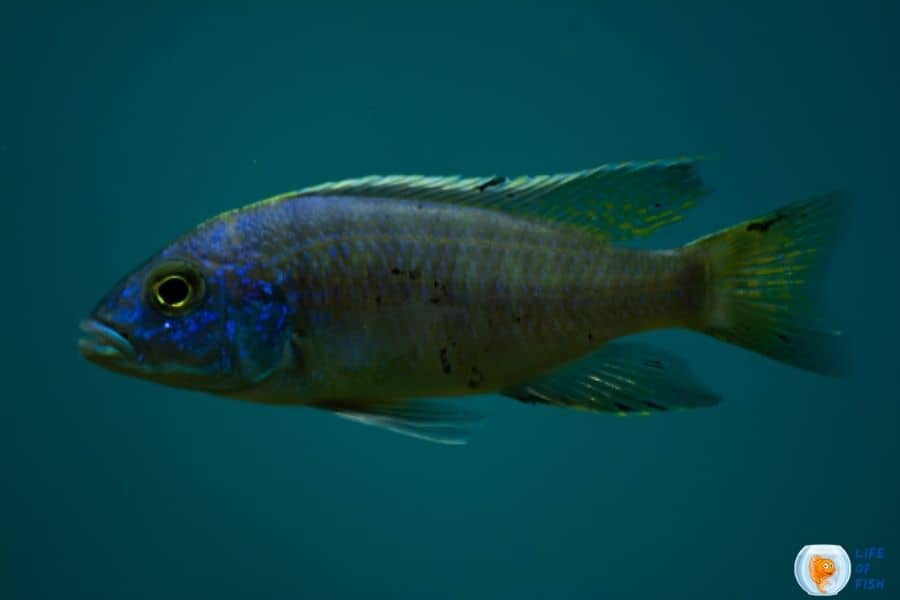Cichlid is popular fish species in the aquarium industry. But many fish lovers are seeking colorful and compatible fish species of the cichlid family. So, Otopharynx lithobates are the most wonderful option for your aquarium. Actually, their stunning look has the ability to make fish lovers crazy. So, do you like to know interesting facts about this magical fish species?

One Look Care Guide
Jump To
- 1 One Look Care Guide
- 2 What Are Otopharynx Lithobates?
- 3 How Big Do Otopharynx Lithobates Get?
- 4 Is Otopharynx Lithobates Aggressive?
- 5 Otopharynx Lithobates Behavior
- 6 How Long Do Otopharynx Lithobates Live?
- 7 Otopharynx Lithobates Care
- 8 Otopharynx Lithobates Breeding
- 9 How Many Babies Do Otopharynx Lithobates Have?
- 10 Otopharynx Lithobates Fry Care
- 11 Feeding Behavior Of Otopharynx Lithobates
- 12 What Fish Can Live With Otopharynx Lithobates?
- 13 Related Questions
- 14 Is Otopharynx Lithobates Aggressive?
| Scientific name | Otopharynx lithobates |
| Common name | Yellow blaze lithobates cichlid Yellow blaze |
| Care level | Moderate |
| Native to | Lake Malawi, Africa |
| Color | Bright blue with yellow |
| Tank size | Minimum tank size 55 gallons |
| Preferred temperature | 75 to 82 Fahrenheit 34 to 28 Celsius |
| Other water parameters | pH levels – 7.6 to 8.8 Water hardness- 10 to 25 dH |
| Growth rate | No exact growth rate |
| Temperament | Semi aggressive |
| Recommended tank mates | Other less aggressive Haps Lake Malawi Peacocks Hard water rainbow fish Some cyprinids |
| Preferred food | High-quality cichlids pellets and flakes |
| Feeding frequency | 2 to 3 times per day |
| breeding | Possible in captivity |
What Are Otopharynx Lithobates?
Otopharynx lithobates is a true rock dweller fish. Also, this fish is a Haplochromis that belongs to the family Cichlidae. However, Otopharynx lithobates are known as Yellow blaze lithobates cichlid. This fish is very rare to see in open water. But many hobbyists tend to rear Otopharynx lithobates because of this really stunning look.
This fish species has bright yellow blaze running over its head and down the edge of the dorsal fin of its tail. So, imagine how much this colorful blaze with blue color pointed body adds vibrancy and value to this fish. Simply it is impressive! This gift is offered for a fish world by Lake Malawi, Africa. Because this fish species’ natural habitat is Malawi lake. Now they live in aquariums worldwide.
According to the records, when looking deeply at their natural homes, Otopharynx lithobates can be found between Domwe Island and Monkey Bay and at Thumbi (East and West), Mumbo Chinyamwezi, and Zimbabwe Rock. However, many colorful varieties are living near the Zimbabwe rock. But it is the best one I have ever seen. In fact, the male Otopharynx lithobates do the best.
How Big Do Otopharynx Lithobates Get?
Generally, well-grown adult males can reach 6 to 6.5 inches long, including their tails. However, this maximum size is ideal for 80 gallons of water or more tanks. When it turns to female Otopharynx lithobates, they are smaller than male fish. However, if you want to keep the best health and grow Otopharynx lithobates, do not forget to look after them well.
Is Otopharynx Lithobates Aggressive?
It is one of the mildest cichlids in Lake Malawi. Simply this fish can be introduced as a semi-aggressive fish. However, Otopharynx lithobates can live with selected fish species that do not show aggressive behaviors. The male Otopharynx lithobates show supper-aggressive levels and become territorial during breeding seasons, especially for other male fish.
In addition to that, this aggressiveness of males in breeding can give bad results. For instance, males will relentlessly chase after a female and may kill her if she is not ready to breed. So, to spread this aggression level, you can keep one male with several female fish. Further, it is not good to keep small fish species with Otopharynx lithobates. Because they can be aggressive and recognize small fish as prey.
Otopharynx Lithobates Behavior
They are rock dwellers. So, it isn’t easy to see them in open water. Also, they are semi-aggressive fish species. But the males are more aggressive during the spawning period.
How Long Do Otopharynx Lithobates Live?
They can live for several years under optimum care level. However, generally African cichlids have the ability to live about 8 years. So, if you care for your fish with excellent water conditions and premium foods, sure, your fish can live long, sometimes more than eight years. But do not worry if your look after them well; they will breed and produce the next generation of fish for your aquarium.
Otopharynx Lithobates Care
Otopharynx Lithobates Tank Size
Generally, the recommended minimum tank size is 55 gallons tank. However, I recommended using about 80 gallons of tank. Because they are pretty large when they become adults. Also, this fish species is best in 100, 120, or 150 gallons. However, you should add at least 5 gallons per fish. Also, when you select the tank size, considering the number of Otopharynx lithobates and other fish species that you are going to rear is compulsory.
How Many Should Otopharynx Lithobates Be Kept Together?
Generally, it is better to keep one male with several females. Because when spawning, males are very aggressive and territorial, especially towards the male fish. Anyhow if you need to keep more males, you should ensure that you have adequate space.

Tank Setup
Before setting up the tank for any fish, it is vital to be aware of their natural habitats because you should mimic the natural environment where they belong to. Thus, it will help to keep healthy and happy fish. So, when it turns to Otopharynx lithobates, they are rock dwellers, and they prefer to live among rocks and caves. So, you have to add piles of rocks. Also, it is better to arrange form caves with areas of open water.
However, many hobbyists misunderstand that Otopharynx lithobates have gravel when selecting substrates. No, it is not compulsory. However, you can use fine gravel. Also, keep in mind, that the layer of gravel more than ¼ inches thick allows it to contain uneaten foods. Consequently, it will spoil your water quality. So, it is better to choose sand as a substrate for your Otopharynx lithobate tank from my perspective.
When it turns to live plants, they do not damage the vegetation in their tank. But live plants are not essential. The same theory applies to driftwood too. Here you have to go with the live plants that can survive in hardy water such as Anubias and Vallisneria. But if you wish to add live plants and driftwood, do not overload them. It is better to limit it to one or two plants. Another important thing is the filter system. You have to choose a high-quality filter because it will play the main role in keeping your tank water clean.
Water Quality Condition
You should keep water quality at the ideal level because it will help to generate healthy fish. So, when you rear Otopharynx lithobates, you should ensure that the water parameters are below levels. Water temperature: you should keep the water temperature at 75 to 82 Fahrenheit or 34 to 28 Celsius. Here, if you prefer, you can use a heater to maintain the optimum temperature level in your fish tank.
pH level: it is a must to keep the pH level between 7.6 to 8.8.
water hardness: hardness should be between 10 to 25 dH.
Special Note: You can use additives such as Cichlids lake salt and Malawi/ Victoria buffer to condition the African cichlid aquarium water.
Otopharynx Lithobates Breeding
Otopharynx Lithobates Male Or Female Identification
When they are in the juvenile stage, it is challenging to identify male and female Otopharynx lithobates separately. But when they grow gradually, it is easy to identify the gender difference of Otopharynx lithobates due to their size and colorfulness. So, as usual, male Otopharynx lithobates are larger than female fish. If I explain the difference in the color combination of Otopharynx lithobates males and females, both males and females are gray when they are small.
But when gradually mature, the male fish turn their bodies into stylish dark blue coloration. Also, they begin to show their unique signature “yellow color blaze” that runs from their nose to the back of their dorsal fin around 3 inches long. However, some male fish show yellow color on their bodies too. In addition some males obtain a more orange color on the blaze and dorsal fin with age. But female remains their bodies in gray color, but there is some Blue tint.
Identify Pregnant Otopharynx Lithobates
Female fish are egg layers. So, they do not be pregnant. But when they mature gradually, they are ready to breed. At this point, sometimes, their belly can be a bit more rounded and more prominent than usual.
Otopharynx Lithobates Breeding
The happy news is that you can breed your Otopharynx lithobates in captivity! Here you can set up a separate breeding tank for them. It will give a comfortable feel to the breeding couple and other tankmates. Because when spawning, male fish is aggressive. Here do not forget to choose a tank with enough space as a breeding tank. Also, the important thing is that you have to add flat stones to this tank because these flat stones act as potential spawning sites.
Further, highly concerned about the water quality of the breeding tank. Do you know the ideal water parameters for Otopharynx lithobates breed? The water temperature should be between 77 to 80 Fahrenheits while the pH level is 8.2 to 8.5. Then you should select at least one male with three females as breeding fish because it will reduce the aggression level of the male fish.
However, if you keep several male Otopharynx lithobates, one male fish will become dominant, and only this particular fish develops full breeding dress and breeding with the females. Then feed your Otopharynx lithobates fish using plenty of live and frozen foods. Because in breeding seasons, they need more nutrients. Not only that, nutrients rich foods will motivate the breeding process.
When male fish are ready to spawn, they will display intense color around their chosen spawning site. The male shows this behavior to attract female fish to mate. Also, the spawning site is probably a flat rock in a safe location at the bottom of the breeding tank. So, when the female is willing to mate, she enters the spawning site and lays eggs on it.
When the female lays the eggs, the pair will circle around each other. Then Simultaneously, the male fish fertilize the eggs. After fertilization female takes eggs into her mouth because Otopharynx lithobates are mouthbrooders. However, before releasing the free-swimming Otopharynx lithobates babies, female fish can carry the brood of 20-25 eggs for up to 4 weeks. Female fish does not eat at this time, and you can easily distinguish the female fish by its distended mouth.
Similarly, you should have a huge responsibility to take care of her. Because if female fish is stressed, she can spit out the babies prematurely or eat them. However, if female fish isolate from the colony for too long, they can lose their position in the group’s pecking order. So, it is also worth considering it. Because of these reasons, if the female fish is not being harassed, I recommend waiting as long as possible before moving the female fish. However, some commercial breeders take fry out in artificial ways from the mother’s mouth at 2-3 weeks.

How Many Babies Do Otopharynx Lithobates Have?
It is difficult to answer with the exact number. But Otopharynx lithobates fry may usually be in the 15 to 40 range.
Otopharynx Lithobates Fry Care
Feeding Behavior Of Otopharynx Lithobates
They are carnivores. So, they accept only meaty foods. Also, do not forget to provide protein-rich foods.
What Do They Eat ( In The Wild And In The Aquarium)
Generally, They are a group of rock dwellers. So, why do they need to swim here and there to find food in the wild? There are many foods near them. Simply, Otopharynx lithobates eat invertebrates. But in captivity, you can provide high-quality commercial foods such as pellets and flakes. These are specially prepared for cichlids. So, these pellets and flakes help to keep your fish healthier and more colorful.
How often should you feed
You can feed them 2 to 3 times per day. Further, do not let them overfeed. It is better to provide foods that your fish can finish within 2 to 3 minutes.
When should you feed (time of the day)
Generally, you can feed them in the morning and evening if you choose to feed them twice per day. If not, you can feed them morning, afternoon, and evening if you provide a small amount 3 times per day.
How long they can go without food
Well-grown healthy fish can live 7 to 10 days without fish foods, and this can be varied due to the availability of foods in your aquarium. But baby cichlids can live for 1 to 2 days without fish foods.
What Fish Can Live With Otopharynx Lithobates?
They are non-aggressive fish species in the cichlids family. So, you can keep the below fish species with Otopharynx lithobates.
- Other less aggressive Haps
- Lake Malawi Peacocks
- Hard water rainbow fish
- Some cyprinids
However, do not keep small fish species with Otopharynx lithobates. Always try to keep your Otopharynx lithobates with the same size fish. Not only that, it is important to avoid aggressive or boisterous fish species in Otopharynx lithobate tank.
Related Questions
Is Otopharynx Lithobates Aggressive?
The answer depends on the situation. But Otopharynx lithobates are not aggressive at all. However, not like other cichlids, Otopharynx lithobates are semi-aggressive. They are peacefully dealing with other selected fish species. But during the breeding seasons, the male Otopharynx lithobates show more aggressive behaviors. For instance, male fish are more territorial and aggressive, especially towards other male fish.
On the other hand, if your keep small fish with Otopharynx lithobates in the same home, they can eat these small ones. Because, Otopharynx lithobates can be misunderstood by these small fish as their foods, not tankmates.
Read Next : Cuckoo Wrasse ( Their Color Is Out Of This World )
